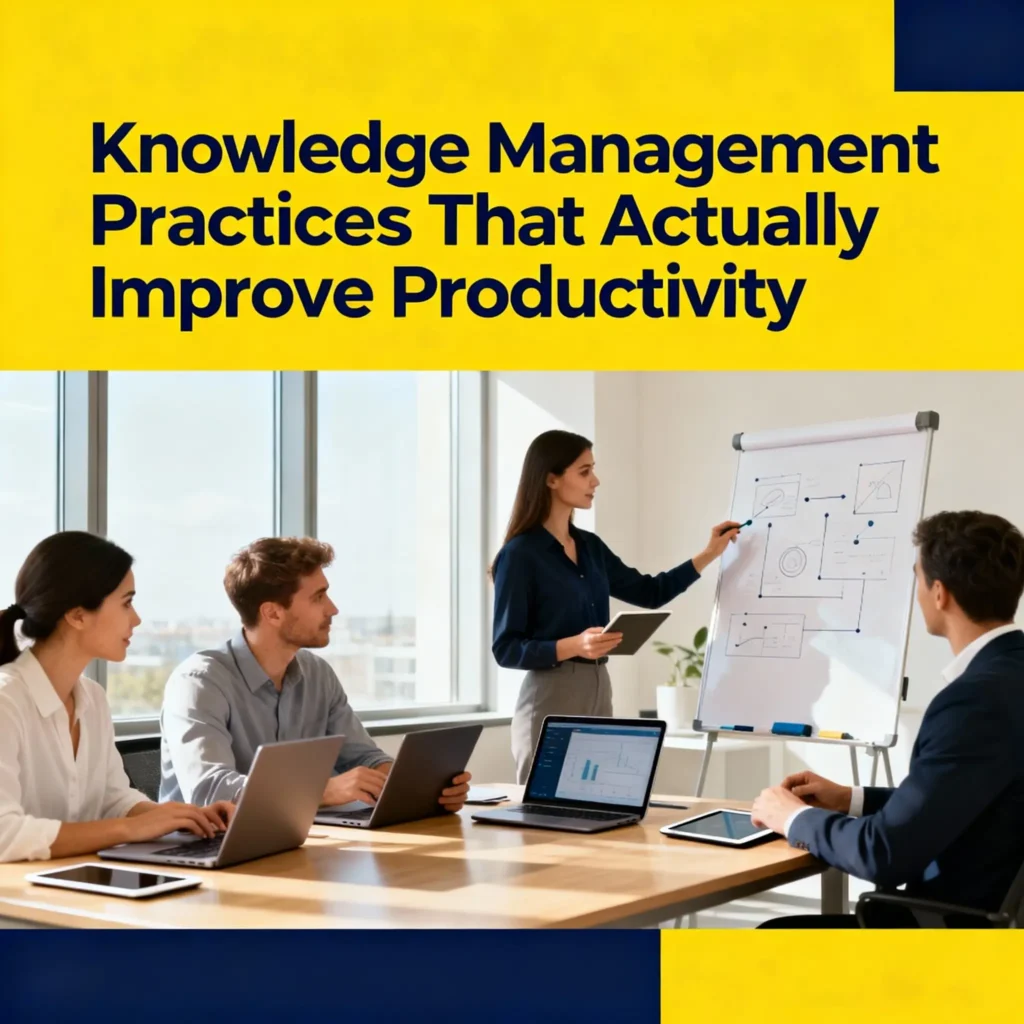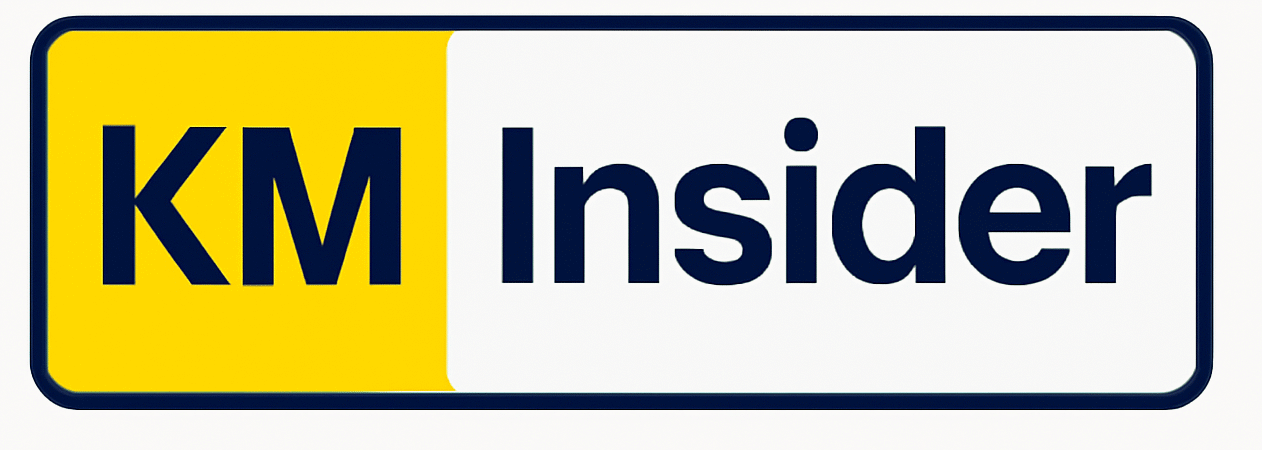In many organizations, productivity isn’t just about working harder—it’s about working smarter. And at the heart of working smarter lies knowledge management (KM). Despite being a buzzword for decades, knowledge management often gets misinterpreted as a fancy library of documents or a glorified SharePoint. In reality, when done right, KM is a strategic lever that can transform how teams operate, make decisions, and innovate.
But the question remains: which KM practices actually boost productivity instead of creating more noise? Let’s unpack the practices that deliver real, measurable impact.

1. Making Knowledge Accessible, Not Just Stored
One of the most common pitfalls in KM is treating knowledge as a static asset. Organizations invest in databases, repositories, and intranets, only to watch employees struggle to find what they need when they need it. This is where productivity takes a hit.
The practice that works: implement contextual knowledge access. Instead of dumping files into a repository, organize knowledge in a way that aligns with workflow. Tag documents with project names, department, client, or stage of process. Use search tools powered by semantic search or AI-assisted recommendations to help employees discover relevant knowledge intuitively.
Example: At Deloitte, teams working on client projects can instantly access previous proposals, research insights, and lessons learned from similar engagements. This eliminates redundant work and reduces the time spent reinventing the wheel.
2. Capturing Tacit Knowledge Before It Walks Out the Door
Some of the most valuable knowledge in an organization resides in people’s heads—often referred to as tacit knowledge. Without proactive capture, this expertise leaves the company the moment an employee departs.
High-value practice: structured knowledge harvesting sessions and mentorship programs. Encourage senior professionals to document best practices, lessons learned, and decision rationales. Combine this with storytelling formats, not just bullet points or manuals. People remember stories; stories guide behavior and decision-making.
Real-world impact: NASA maintains a practice called “lessons learned debriefs” after every mission. These sessions capture critical tacit knowledge, which is then accessible to future teams, preventing costly mistakes and accelerating project timelines.
3. Integrating Knowledge Into Daily Workflows
A common mistake is expecting employees to “go to KM” rather than “KM coming to them”. Productivity spikes when knowledge tools are embedded directly into daily workflows rather than existing as separate systems.
Practical approach: integrate knowledge management platforms with tools employees already use—project management systems, CRM software, or collaboration platforms. Knowledge should be push-driven, providing relevant insights at the point of need.
Example: IBM’s Watson Knowledge Catalog integrates with collaboration tools to suggest documents, precedents, or guidelines while employees are drafting reports or proposals. This reduces the time spent searching for information and keeps momentum going.
4. Fostering a Culture of Knowledge Sharing
Even the most sophisticated KM tools fail if people don’t actively share knowledge. Many organizations struggle with knowledge hoarding, whether due to competition, lack of recognition, or simply inertia.
Actionable practice: build knowledge-sharing incentives into performance metrics. Recognize contributions to knowledge repositories, encourage peer-to-peer learning, and celebrate teams that actively leverage and share insights.
Cultural nuance: it’s not about mandatory KM; it’s about making knowledge sharing habitual. Google’s internal wiki system, for instance, thrives because it’s part of the workflow and team members see immediate value in contributing and accessing shared knowledge.
5. Continuous Updating and Validation of Knowledge
Knowledge stagnates fast. A document that’s a month old in a fast-moving industry can already be obsolete. Outdated knowledge isn’t just useless—it’s dangerous, leading to wrong decisions and wasted effort.
Effective practice: implement knowledge stewardship roles. Assign accountability to individuals or teams to review, update, and validate content regularly. Combine this with analytics to track which knowledge is used or ignored, prioritizing updates accordingly.
Example: At McKinsey & Company, practice leads maintain sector-specific knowledge bases, continuously updating them with case studies, market insights, and internal learnings, ensuring consultants always have current, actionable knowledge.
6. Leveraging Technology Without Losing the Human Touch
It’s tempting to rely solely on AI, automation, or advanced KM platforms. But productivity gains come from smartly combining human expertise with technology, not replacing judgment.
High-impact practice: use AI to surface insights, identify gaps, or recommend content, but let humans curate and contextualize knowledge. Knowledge management should be seen as a collaboration between humans and technology rather than a fully automated system.
Example: Shell uses AI-driven knowledge analytics to flag outdated safety procedures or highlight recurring issues, but subject-matter experts review and refine recommendations before they’re applied. This approach reduces errors and enhances learning.
7. Making Knowledge Actionable
Knowledge management isn’t about hoarding information; it’s about enabling action. Actionable knowledge provides clear steps, best practices, or decision frameworks that employees can apply immediately.
Practice that works: create decision-support KM systems that link knowledge to specific tasks, processes, or roles. Include checklists, templates, or interactive guides rather than just textual content.
Example: A leading global bank implemented a KM system that tied compliance knowledge directly to employee workflows. Instead of reading manuals, employees received real-time prompts and guidance, dramatically reducing errors and training time.
8. Measuring KM’s Impact on Productivity
Without metrics, it’s impossible to know if your KM practices are truly improving productivity. But traditional KPIs like “number of documents uploaded” don’t cut it.
Effective approach: focus on outcomes, not outputs. Measure how KM contributes to:
- Time saved on routine tasks
- Reduced duplication of effort
- Faster onboarding
- Increased project success rates
- Decision accuracy
Insight: At Procter & Gamble, internal surveys combined with analytics track how KM access correlates with project delivery speed, highlighting which knowledge assets have the highest impact.
9. Encouraging Cross-Functional Collaboration
Knowledge doesn’t thrive in silos. Productivity spikes when teams can share insights across departments and geographies.
Practice: create communities of practice where professionals from different teams or locations regularly exchange learnings. Encourage asynchronous contributions—forums, discussion boards, and collaborative KM platforms—so knowledge flows even when schedules don’t align.
Example: Siemens established global engineering communities of practice where project learnings are shared across continents, cutting repetitive design work and accelerating innovation.
10. Continuous Learning as a KM Core
Finally, knowledge management should be woven into the culture of continuous learning. Organizations that link KM to professional development, learning programs, and innovation initiatives see tangible productivity improvements.
Implementation: connect KM with learning platforms, microlearning, or mentorship programs. Encourage employees to both consume and contribute knowledge as part of career growth, not just operational tasks.
Example: At Accenture, KM and continuous learning are integrated. Employees contribute insights from client projects, which then feed learning modules, making knowledge both reusable and an avenue for skill development.
Final Thoughts
The reality is that knowledge management is only as good as the value it creates in daily work. Organizations that treat knowledge as a living, accessible, actionable, and human-driven resource unlock real productivity gains.
From making tacit knowledge visible to embedding KM directly into workflows, these practices go beyond checklists and tools—they reshape how people work, collaborate, and innovate. Productivity isn’t just about doing more; it’s about working smarter with the right knowledge at the right time.
By focusing on accessibility, cultural adoption, actionable insights, and technology-human synergy, KM becomes less of a “back-office function” and more of a strategic engine driving organizational performance.
